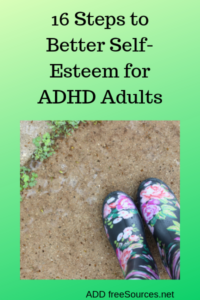The reason for making this list is that ALL (or most) ADHD’ers have a low self-esteem issue. I wanted to make this list to help myself as well as others.
Follow my steps to a better, more confident YOU!
After all, I made this list for my tribe!!
Let’s get started!
Your first step is STRUCTURE.
By creating structure, each day, you’re giving yourself a reason to wake up and get out of bed!
The second step echoes the first step. Set up a daily to-do list. This will give you a sense of accomplishment (it gives you a reason to be proud of yourself).
Step 3. FOCUS on your good qualities. Look in the mirror and choose 5 things about yourself that you DO like about you! Write these 5 things down and tape it to the mirror (changing the 5 things each week). By choosing 5 things you do like about yourself, you’re creating hope and mindfulness that goes deep down to create a feeling of inner peace. Inner peace leads to a sense of power and in a matter of weeks, a more confident you!
4. Be your own cheerleader! No one else will do it for you. Your only concern should be you. If you have to, tell yourself, “I can do this”, “I am going to do great”, “I AM worthy”.
5. Learn to LIKE yourself. Meditation works wonders!! Sit in a quiet place for 10 minutes and just breathe in and exhale all of that negativity.
6. Get CREATIVE. Do-it-yourself projects, draw/sketch something, crochet or paint a landscape. Anything that makes you use your mind in a positive, constructive way.
7. Get ACTIVE! This means anything from exercise to waking up your street. You could also try Yoga or Karate. This activates the positive chemicals in your brain- happy vibes! If all else fails, DANCE!
Number 7 would tie in perfect for the eighth step as well, which is,
SEEK SUPPORT. This can be a family member, a close friend, a Facebook support group or any other networking support groups. Enlist someone you trust to get active with you. Killing two birds with one stone is always a plus! By enlisting a close friend or relative, you’re getting the support aspect as well as working those happy brain cells. If you make this a habit and decide, “I’m not up for this today”, that partner will get your butt up and make you do it! Ah, support is great!! That brings me to number
9. All of us could use a little pep in our step and we’re not getting there by loading up on donuts. Try introducing a, once a day, healthy snack. This will promote energy and unlike donuts, won’t bog you down. With time, you can baby-step your way to healthier meals. Instead of that scone in the morning, try a banana and yogurt. Protein and potassium make for a great and energizing way to start your day. An apple with peanut butter is a great option as well. Make that apple and peanut butter a snack and you have a totally guilt-free snack and an afternoon burst of energy!
10. GET Outside or change the scenery. It’s a great way to promote a healthy mentality and a happier you.
11. TAKE CARE OF YOU! The world is an amazing place, but it’s also very stressful at the same time. Take time for yourself. Get a massage, pedicure or do something you love. (We’re nearly there!)
12. TRY SOMETHING NEW! This is a way to get out of your comfort zone. Say you decide to try Yoga, well, some of those stretches are hard to do. Go with me on this. You sign up for a class, get in there and do better than other first-timers. That will boost your confidence and make you proud that you were able to try something new and excel! If you don’t do as well, hey, practice makes perfect and you’re working your way up to a brilliant confidence level while achieving a goal. That is definitely something to be proud of. It’s a double plus!
13. LEND A HAND! This is a no-brainer for me. I love helping. It makes my inner self-pleased to do something completely selfless and the reward- a smile on someone’s face. Examples of ways to help out are volunteering, helping an elder struggling to carry groceries, etc. Get creative and look around. There’s always someone out there that needs a little assistance.
14. STEP IT UP. Comfort zones are hard to get away from but in order to succeed anywhere in life, you must step it up. Put on a smile (even if you’re not feeling it.) You never know who will see your smile and it impacts their day and mood positively or, to go a bit further, your smile could save a life. I’m not kidding – Those people that are lonely, that never get noticed, the ones that keep a frown because no one cares – You notice. STEP IT UP, greet them. You may be preventing them from ending their life.
15. MEDITATE every morning to promote a peaceful mindset and every night before bed to promote a healthy, restful night’s sleep to wake refreshed and ready to begin your day.
16. BABY STEPS. Nothing happens overnight (Rome wasn’t built in a day), contrary to beliefs and otherwise. Start out slow and work your way up. All good things come with time, so be patient.
Finally, REINFORCE STEPS 1-16 each and every day. A healthier mind and body lead to a happier and more confident YOU!
 Allow yourself to follow these steps and you will surely improve your esteem!
Allow yourself to follow these steps and you will surely improve your esteem!
Just remember, I believe in you!
About the author: By Kari Taylor-Hogan of ADDing to the Mayhem: MOMX3 with ADHD – “We put the fun in dysfunctional.” Helping get the word out about self-esteem. Originally published at https://addingtothemayhemmomx3withadhd.wordpress.com/2015/02/09/16-steps-to-better-self-esteem/
16 Steps Photo by Jen Theodore on Unsplash
Title photo created on Canva.com
Believe in Yourself “Image courtesy of Stuart Miles/FreeDigitalPhotos.net”
Modified on Canva
Check out Pinterest for more on self-esteem, self-advocacy and believing in yourself.
Follow ADHD / ADD freeSources’ board Self Advocacy on Pinterest.
Follow ADHD / ADD freeSources‘board Resiliency – Believe on Pinterest.





